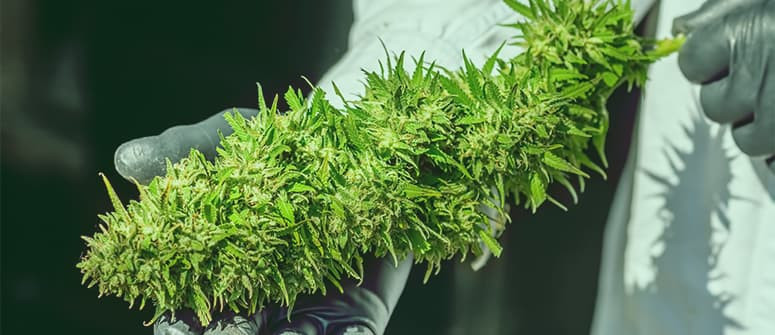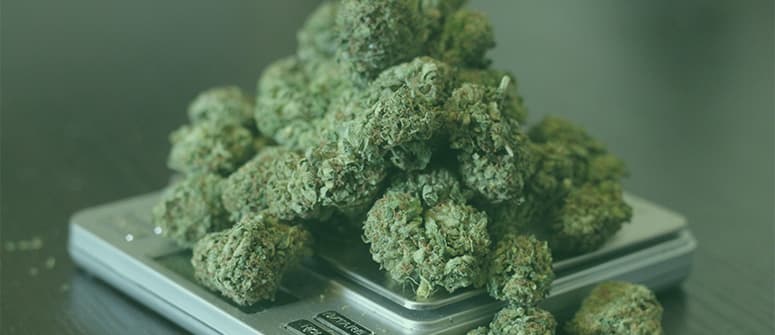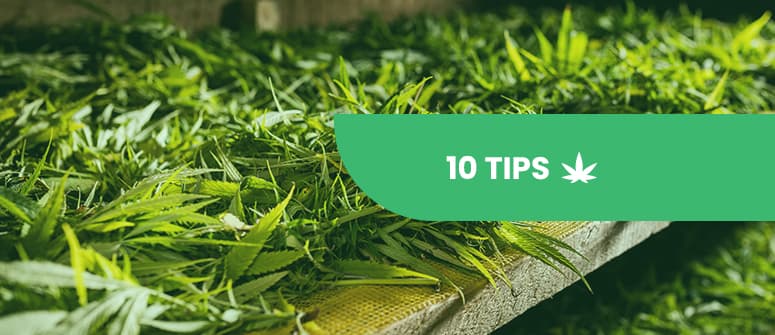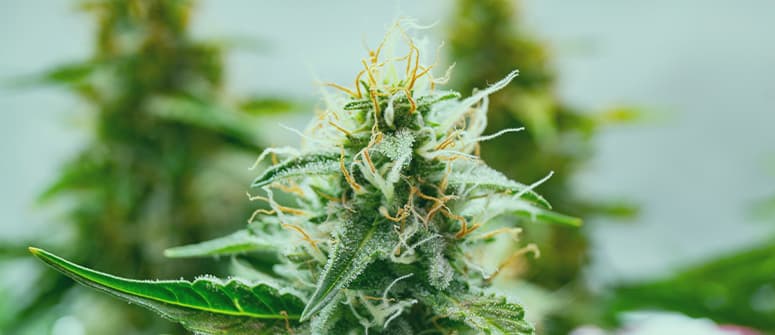How to maximise autoflowering cannabis yields — Top 10 tips

Planning on growing some autoflowering cannabis plants? Want to push your harvests to the limit, without hurting your precious specimens? Don't do anything before reading these 10 tips! We'll get you on the road to achieving heavy yields from healthy autos.
Contents:
Heard the hype surrounding autoflowers? Autoflowering cannabis strains are fast to finish, compact, and, of course, flower automatically after just a few short weeks of growth. However, mastering the art of growing this unique subtype of cannabis can be tricky, especially when it comes to maximising yields. In this article, we'll share 10 tips to help you master growing autoflowers, so you can rake in the biggest harvests possible!
How much can autoflowering cannabis yield?

Seed banks regularly advertise their autoflowers as capable of producing anywhere from 50 to 500g/m² (or even more) indoors. Per plant, some autos are said to be able to churn out 300g or more, but this is a high estimate. Keep in mind that seed banks publish their yields based on wet harvest weight (which will reduce by up to 75% post-drying and curing). Also, remember that these measures are generally based on perfect or near-perfect growing conditions, which might be hard to replicate for some hobby growers.
Therefore, we estimate an intermediate grower working with solid genetics and a modest growing setup should be able to harvest between 50 and 150g wet (or 30 and 80g dry) of bud per plant. Note, however, that there are many variables that can affect yield, which we'll explore in more detail below.
Autoflower vs photoperiod yields
Autoflowers have long been criticised for their meagre yields. And while these criticisms were valid when autoflowers first became “commercially” available, they are irrelevant today. Modern autoflowering strains can produce exceptional yields that'll meet the needs of commercial cultivators, and far exceed those of hobby home growers.
If you're used to growing photoperiod strains, it is important to manage your expectations when experimenting or transitioning over to autoflowering plants. Unlike photoperiod cannabis, autoflowers have a limited vegetative cycle that lasts roughly 3–4 weeks.
While there are exceptions to this rule, autoflowers generally grow smaller than photoperiod strains (which can essentially be left to veg indefinitely), especially if they encounter stress. As a result, autoflowering plants typically produce slightly lighter yields than their photoperiod cousins, though this will vary based on your growing skills and style.
In general, the gap in yields between autoflowering and photoperiod strains is closing dramatically thanks to new genetics and improved breeding.
10 tips for bigger autoflower harvests

While they boast the simplicity of flowering automatically, the unique grow traits of autoflowering cannabis plants can make it difficult to achieve max yields. With the 10 tips below, however, you'll enjoy great autoflower harvests at home with ease.
1. Pick the right strain
First things first; your yields will only be as good as your genetics allow them to be. In order to ensure the biggest harvests, it's important to invest in quality genetics from respected seed banks. Buying autoflowering cannabis seeds that were bred to produce stable plants with good yields gives you a much greater chance of success compared to buying any old seeds. It'll also ensure the money you spend on fertilisers, soil, grow equipment, lighting, etc., doesn’t go to waste on a subpar strain with little potential.
Cannabis seed banks and breeders are dedicated to creating strains that not only yield more flower, but also produce buds that are heavier and more resinous. Well-bred autoflowers will produce flowers with big, swollen calyxes and a good calyx-to-leaf ratio (which makes for heavier yields and simplifies trimming). Companies obviously also breed their strains for vigour, and you'll notice that quality autoflowers grow fast and strong, while also showing natural resilience to pests, pathogens, and environmental stress.
2. Germinate autos in their final pots
While photoperiod strains respond really well to gradual transplanting, autoflowers don't. Given their short vegetative stage, autoflowers typically won't fully recover from the stress of being transplanted before flowering. In turn, transplanted autoflowers may show signs of stunted growth, resulting in smaller plants with fewer bud sites, and thus lower yields. Moreover, they tend to develop light, airy flowers, and may even develop male flowers (hermaphroditism) in response to the stress.
No matter how careful you are when transplanting your green ladies, the simple process of uprooting and replanting naturally causes stress. When growing photoperiod strains, you can help to compensate for this by extending the veg period of your plants, giving them time to recover from the stress of transplanting before entering bloom. This isn't possible when growing autoflowers, which is why you should germinate autoflowering seeds in their final pots.
3. Stick to an 18/6 light schedule
Autoflowers came about from the discovery of Cannabis ruderalis, a unique cannabis subspecies that grows in places like Siberia and other parts of Russia. Unlike indica and sativa varieties, Cannabis ruderalis flowers naturally after about 4 weeks of vegetative growth. Today's autoflowers contain roughly 10% ruderalis genetics or so; enough to give them the autoflowering trait while still allowing for high levels of cannabinoids and big, dense flowers from their indica/sativa parents.
Thanks to their ruderalis genetics, autoflowers do not require a change in the light cycle to begin flowering. Hence, to maximise growth during their short life cycle, it is recommended to keep them under an 18/6 light schedule from seedling through to harvest.
4. Avoid high-stress training
Photoperiod strains respond extremely well to training. Techniques like pruning, topping, and super cropping can push plants to produce the best possible yields. Autoflowers, however, don't respond well to high-stress training (HST). Again, this comes down to their short life cycle and automatic transition from veg to bloom. Since there is no way to keep an autoflowering strain from flowering, it is hard for them to recover fully from the stress of HST before they start to bloom. In turn, HST in autoflowers usually does more harm than good, resulting in stunted plants and poor yields.
Traditionally, growers and breeders recommended not using any training methods on autoflowers whatsoever. Today, however, a growing number of cultivators swear that implementing some low-stress training (LST) can help them produce bigger, more uniform flowers.
5. Try sea of green (SOG)
Sea of green, or SOG, is a style of cannabis cultivation that involves growing numerous small plants in close proximity, maximising light exposure and available space. Come harvest, the grow space should be filled with, well, a sea of green plants with an even canopy. In fact, SOG is a favourite among commercial growers for its ability to produce heavy yields in record time. Autoflowering strains lend themselves particularly well to SOG setups due to their small size and short lifespan.
To grow autoflowers in SOG, you'll first want to pick a strain well-suited to this kind of setup. Look for stocky strains with stable genetics to ensure your plants grow as uniform as possible. Next, plant your seeds in slightly smaller-than-usual pots (10–15l pots work great for autoflowers in SOG) and space them roughly 30–40cm apart. Keep your seedlings under CFL lights during the seedling phase, before flipping them to 18/6 under your regular grow lights and growing as normal.
6. Get the nutrients right
Beginner and experienced growers alike often struggle to properly feed autoflowers. Autoflowers are smaller and typically veg for much shorter periods than photoperiod plants. Hence, it is only natural that they need less fertilisation. Unfortunately, many fall into the trap of overfeeding their autoflowers out of the false belief that more food equals more growth.
For the best results, we recommend growing autoflowers in an organic medium with a good balance of macro and micronutrients. You can prepare this kind of soil at home by combining organic fertilisers such as compost, peat moss, perlite, vermiculite, fish or bone meal, ash, and more.
7. Avoid overwatering
Overwatering is a common mistake rookie growers make as they familiarise themselves with cannabis. While it is a thirsty plant, overwatering can cause serious damage to its roots, stunt its growth, and introduce pests and pathogens into your grow room/garden. Overwatering during the seedling or early veg phase can, in fact, even kill your plants.
Given their smaller size and smaller root structure, autoflowers typically need less water than their photoperiod counterparts. The exact amount of water a plant needs will also vary depending on whether you're growing indoors or out, and the temperatures in your grow room/tent or garden. In general, we recommend sticking your index finger 4–6cm into the growing medium and only watering when it feels dry to the touch.
8. Encourage healthy soil
Soil health is super important when growing cannabis. Healthy soil does much more than anchor down a plant's roots; it also provides an assortment of nutrients to fuel the growth of your plant, as well as a rich combination of microbial life to help it feed, develop strong roots, and stay protected against pathogens and pests.
When growing autoflowering plants, we recommend taking the time and effort to prepare a rich soil for your specimens. Creating your own super soil at home is very simple and provides you with a superior growing medium that'll stand up to (or even beat) any store-bought potting mix. When growing autoflowering marijuana plants in a well-prepared soil, they won't need much more than a light bloom fertiliser and molasses during flowering to produce top-shelf bud. Plus, the simple act of buying all the ingredients and mixing up your super soil at home can be a real eye-opener into plant life.
9. Use fabric grow pots
Fabric pots are quickly becoming a favourite among cannabis growers everywhere. And for good reason; they hold many advantages over classic ceramic or plastic pots. First and foremost, fabric pots promote air-pruning; as a plant's roots reach the edge of the pot and come into contact with oxygen, they automatically prune themselves rather than spiralling around the edge of the pot (and eventually becoming root-bound).
Second, fabric pots allow air to pass around and through your plant's growing medium, which has two main benefits; helping to keep the temperature around the roots optimal, as well allowing your growing medium to dry more rapidly and evenly after watering/feeding. This, in turn, can help to prevent fungal diseases from developing in the root system.
10. Make notes on your grow
Last but not least, one of the best ways to achieve great yields when growing autoflowers (or any type of cannabis for that matter) is to keep a grow journal. Tracking the types of strains you grow and the different variables affecting your grow (soil type, flowering time, fertilisers, etc.) can open your eyes to things that you've done well in your past grows, as well as possible things to improve upon.
When starting a new autoflower grow, consider tracking the following variables in your grow journal:
- The strain you're growing
- The growing medium you're using
- Any fertilisers you're using
- Any pest control measures you’re implementing
- How long your seeds take to germinate
- How long your plants veg and bloom for
- Any complications you run into during the grow (pests, pathogens, hermaphrodite plants)
- Final wet and dry harvest weight
- And much more…
Which autoflowers yield the most?

Autoflowers are definitely causing some hype across the cannabis industry, and for good reason. Today's autoflowering strains boast spectacular yields in record time, and without needing to worry about changing the light schedule. If you're ready to witness the potential of modern autoflowers in your indoor or outdoor garden, make sure to check out our selection of the top 10 highest-yielding autoflowers, and get growing!




